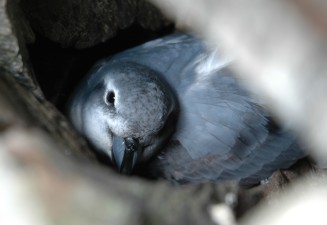NEWS STORY: New study uncovers how petrels co-exist
New study uncovers how petrels in sub-Antarctic co-exist during the winter
For the first time, scientists understand more clearly how birds living on the remote sub-Antarctic island of Bird Island (South Georgia), co-exist successfully. Segregation is key to the survival of four species of petrels, small birds that feed primarily on krill or other zooplankton, during the non-breeding period. The results are published this week in the Nature journal Scientific Reports.
The team studied 25 birds of each of the four species – the blue petrel (Halobaena caerulea), Antarctic prion (Pachyptila desolata), common diving petrel (Pelecanoides urinatrix) and South Georgian diving petrel (P. georgicus). What they noticed was that each species has a different strategy in terms of where they go to spend the winter, what they eat, and their preferred habitat, which means they are not competing against each other for valuable resources.

Dr Richard Phillips, author and seabird ecologist at British Antarctic Survey, says:
“There are usually several species of small (less than 200g) burrowing petrels breeding on islands in the Southern Ocean. This study takes advantage of the recent development of tiny tracking devices, in combination with new techniques to analyse feathers, to provide a much clearer understanding of the distribution and diet of these animals, and the extent to which they co-exist or compete during the nonbreeding season”.
Tiny geolocators (weighing less than 1g), which record light levels, were attached to the feet of the small birds. When retrieved, the time of sunset and sunrise can be extracted and used to estimate latitude and longitude. Analysis of stable isotopes in feathers provides information on trophic level (position in the food web) and distribution.
Read the paper here:
http://www.nature.com/srep/2015/150713/srep12164/full/srep12164.html